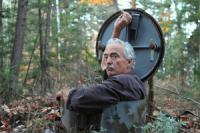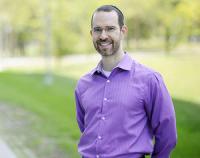-
Humans now affect Earth system more than natural forces
Humans are causing the climate to change 170 times faster than natural forces, new research finds. The study for the first time came up with a mathematical equation to describe the impact of human activity on the Earth system, known as the Anthropocene equation. Over the past 7,000 years the primary forces driving change have been astronomical — driving a rate of change of 0.01 degrees Celsius per century. “Human-caused greenhouse gas emissions over the past forty-five years have increased the rate of temperature rise to 1.7 degrees Celsius per century, dwarfing the natural background rate,” the researchers say.
-
-
Trend: Americans building “doomsday bunkers” in large numbers

It may be a fad of the moment, or an indication of a deeper trend, but people across the United States are building and buying “doomsday bunkers” in large numbers. It is not exactly a new business, but demand for underground bunkers is at an all-time high according to industry insiders. A Texas bunker company saw its sales increase 400 percent in the past two months.
-
-
Recovering from disasters: Social networks matter more than bottled water and batteries

Almost six years ago, on Friday, March 11, 2011, Japan faced a paralyzing triple disaster: a massive earthquake, tsunami, and nuclear meltdowns that forced 470,000 people to evacuate from more than 80 towns, villages and cities. My colleagues and I investigated how communities in the hardest-hit areas reacted to these shocks, and found that social networks - the horizontal and vertical ties that connect us to others - are our most important defense against disasters. As communities around the world face disasters more and more frequently, I hope that my research on Japan after 3/11 can provide guidance to residents facing challenges. While physical infrastructure is important for mitigating disaster, communities should also invest time and effort in building social ties.
-
-
World leaders urged to take action to avert existential global risks
World leaders must do more to limit risk of global catastrophes, according to a report by Oxford academics. He academic define global catastrophe as a risk “where an adverse outcome would either annihilate Earth-originating intelligent life or permanently and drastically curtail its potential.” Three of the most pressing possible existential risks for humanity are pandemics, extreme climate change, and nuclear war.
-
-
Current climate change models understate the problem
A new study on the relationship between people and the planet shows that climate change is only one of many inter-related threats to the Earth’s capacity to support human life. An international team of distinguished scientists, including five members of the National Academies, argues that there are critical components missing from current climate models that inform environmental, climate, and economic policies.
-
-
Broader updrafts in severe storms may increase likelihood of damaging hail
Hailstorms in the United States account for more than $1 billion in damage annually, wreaking havoc on homes, businesses, automobiles, aircraft and agriculture. Recently, these damage totals have increased as people move into hail-prone regions. On 12 April 2016, a supercell storm devastated the San Antonio metropolitan area with large hail, producing approximately $1.36 billion in damage.
-
-
Extreme fires will increasingly be part of our global landscape
Wildfire burned more than 10 million acres in the United States in 2015, and cost over $2 billion to suppress. There were 23 million landscape fires around the world between 2002 and 2013, and researchers define 478 of them as extreme wildfire events. Increasingly dangerous fire weather is forecast as the global footprint of extreme fires expands.
-
-
Disaster Survival Skills launches new disaster preparedness calculator
Seismologists have warned for years about the danger of a so-called “megaquake” devastating the Pacific Northwest upon the rupture of the region’s Cascadian Subduction Zone. Disaster Survival Skills launched its brand-new online Family disaster preparedness calculator. After in-putting a few simple pieces of information, Disaster Survival Skills site visitors will receive a customized list of disaster supplies and advice that can be used to prepare for earthquakes, floods, and other emergencies.
-
-
Deflecting asteroids to prevent their collision with Earth
On 15 February 2013, an asteroid with a diameter of approximately eighteen meters exploded over the Russian town of Chelíabinsk, producing thousands of meteorites that fell to Earth. Many meteorites hit the ground each year, each with a total mass exceeding one ton. An international project provides information on the effects a projectile impact would have on an asteroid. The aim of the project is to work out how an asteroid might be deflected so as not to collide with the Earth.
-
-
Psychological “vaccine” could immunize public against fake news on climate change
New research finds that misinformation on climate change can psychologically cancel out the influence of accurate statements. However, if legitimate facts are delivered with an “inoculation” – a warning dose of misinformation – some of the positive influence is preserved.
-
-
Is the world prepared for another massive volcanic eruption?
An enormous volcanic eruption would not necessarily plunge the world into a new societal crisis, according to a new study of the biggest eruption of the last millennium. One expert says: “Should a massive volcanic eruption occur in the next few years, its consequences for society might still be still difficult to predict, as the world in which we live in is more vulnerable and more exposed.”
-
-
Stopping human-made droughts and floods before they start
Alberta’s rivers are a main source of water for irrigated agriculture in Canada’s Prairie provinces. But climate change and increased human interference mean that the flow of these headwaters is under threat. This could have major implications for Canadian gross domestic product, and even global food security.
-
-
UAlbany names dean of Homeland Security College
The University at Albany has appointed Robert Griffin as its new dean for the College of Emergency Preparedness, Homeland Security and Cybersecurity (CEHC). CEHC was created under the leadership of Gov. Andrew M. Cuomo in 2015, as the first of its kind in the nation. The college is dedicated to advancing educational and practical skills needed to prepare for, protect against, respond to, and recover from a growing array of natural and human-caused risks and threats in New York State and around the world.
-
-
Sound-waves could prevent tsunamis from hitting shoreline
Devastating tsunamis could be halted before hitting the Earth’s shoreline by firing deep-ocean sound waves at the oncoming mass of water, new research has proposed. The researchers believe that lives could ultimately be saved by using acoustic-gravity waves (AGWs) against tsunamis that are triggered by earthquakes, landslides and other violent geological events.
-
-
Earthquakes triggered by humans pose growing risk
People knew we could induce earthquakes before we knew what they were. As soon as people started to dig minerals out of the ground, rockfalls, and tunnel collapses must have become recognized hazards. Today, earthquakes caused by humans occur on a much greater scale. Events over the last century have shown mining is just one of many industrial activities that can induce earthquakes large enough to cause significant damage and death. Filling of water reservoirs behind dams, extraction of oil and gas, and geothermal energy production are just a few of the modern industrial activities shown to induce earthquakes. The only evidence-based way to limit the size of potential earthquakes may be to limit the scale of the projects themselves. In practice, this would mean smaller mines and reservoirs, less minerals, oil and gas extracted from fields, shallower boreholes and smaller volumes injected. A balance must be struck between the growing need for energy and resources and the level of risk that is acceptable in every individual project.
-
More headlines
The long view
Using Drone Swarms to Fight Forest Fires
Forest fires are becoming increasingly catastrophic across the world, accelerated by climate change. Researchers are using multiple swarms of drones to tackle natural disasters like forest fires.
How Climate Change Will Affect Conflict and U.S. Military Operations
“People talk about climate change as a threat multiplier,” said Karen Sudkamp, an associate director of the Infrastructure, Immigration, and Security Operations Program within the RAND Homeland Security Research Division. “But at what point do we need to start talking about the threat multiplier actually becoming a significant threat all its own?”
